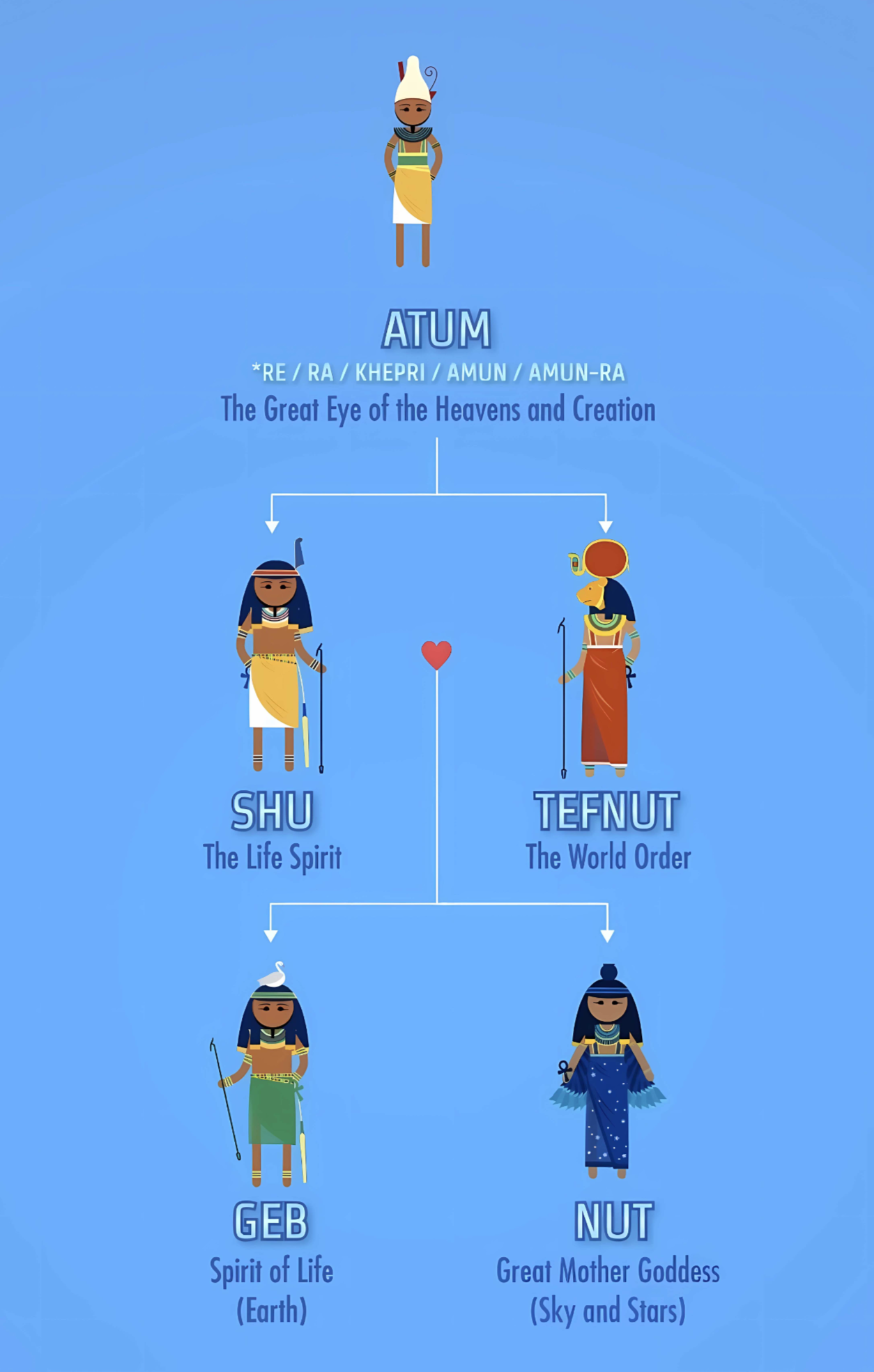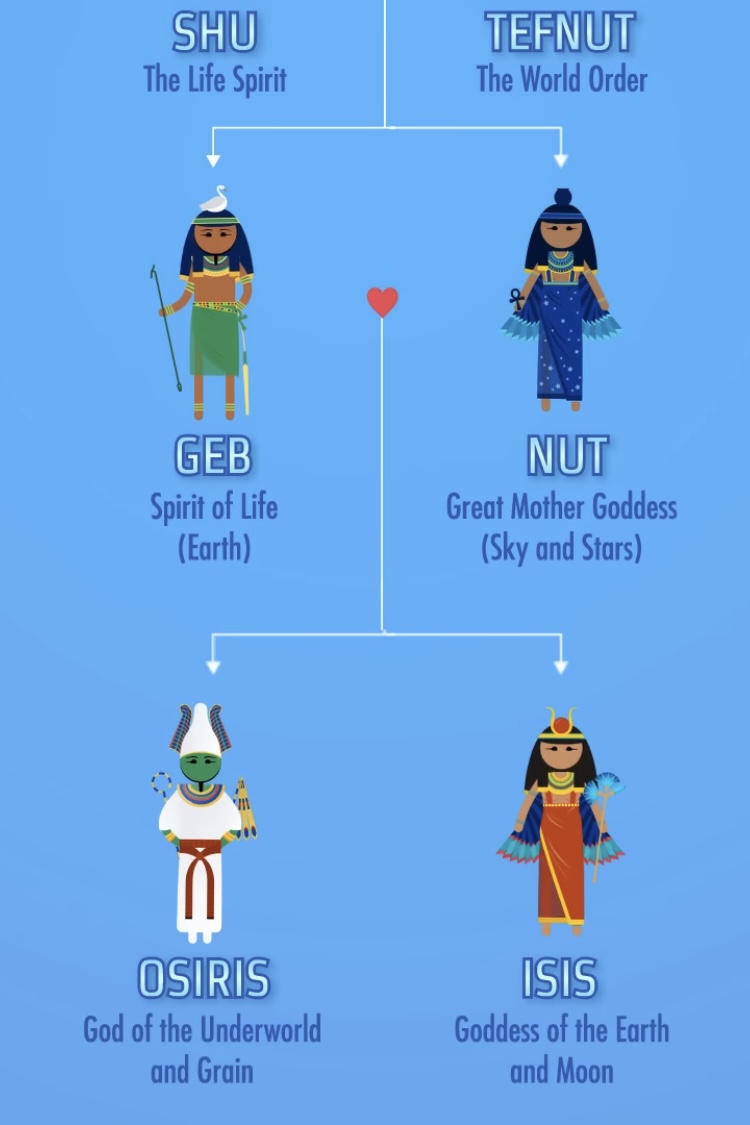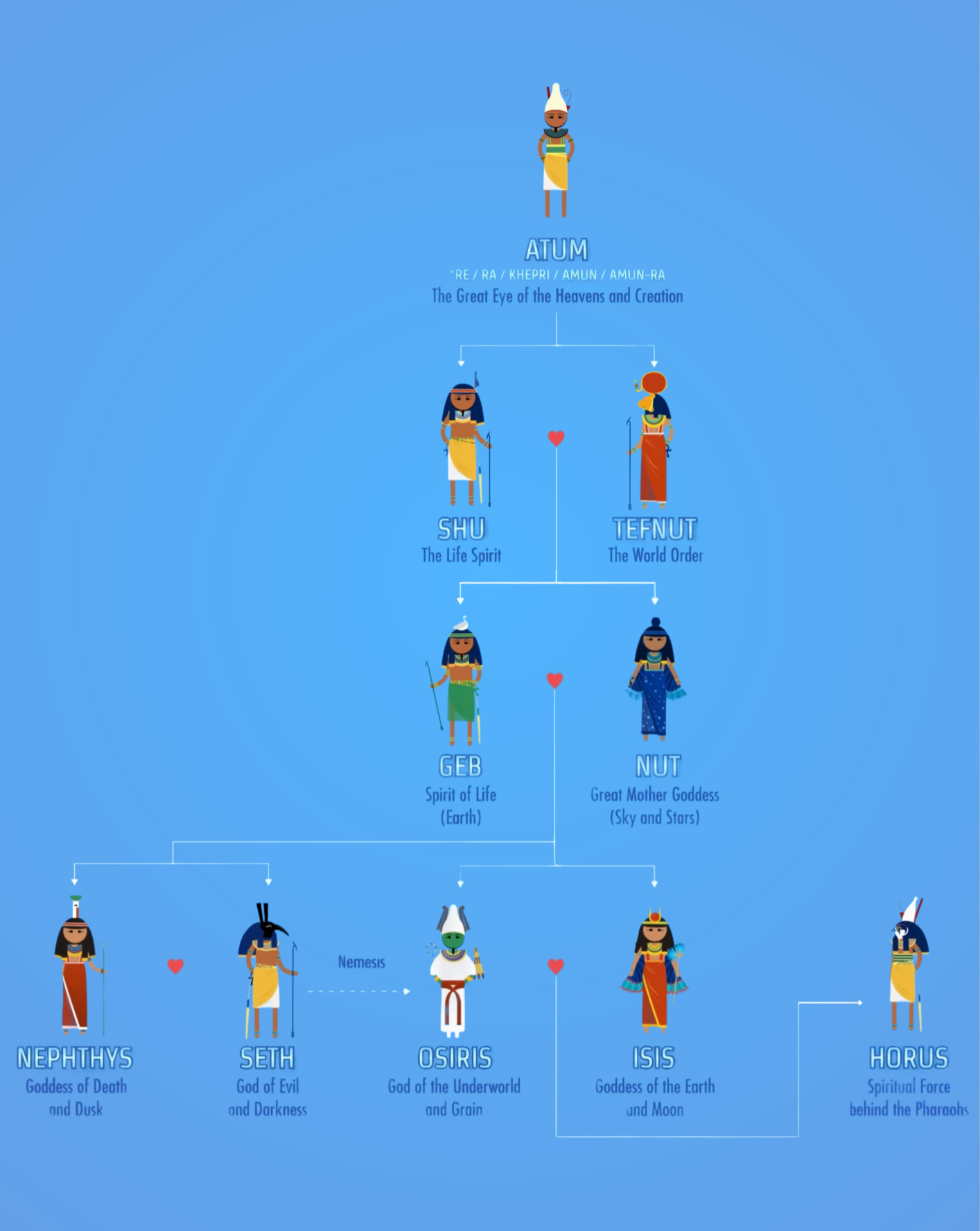



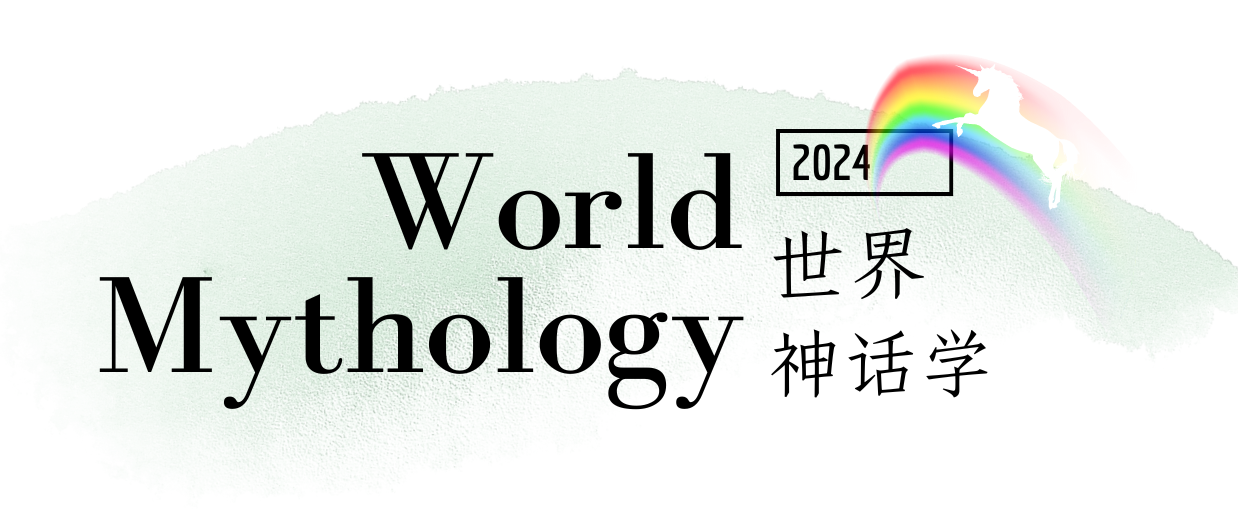
版权归Crash Course公开课所有,本文仅作读文学习使用,如侵权,请联系搬运工删除。
(7)
Pantheons of the Ancient Mediterranean
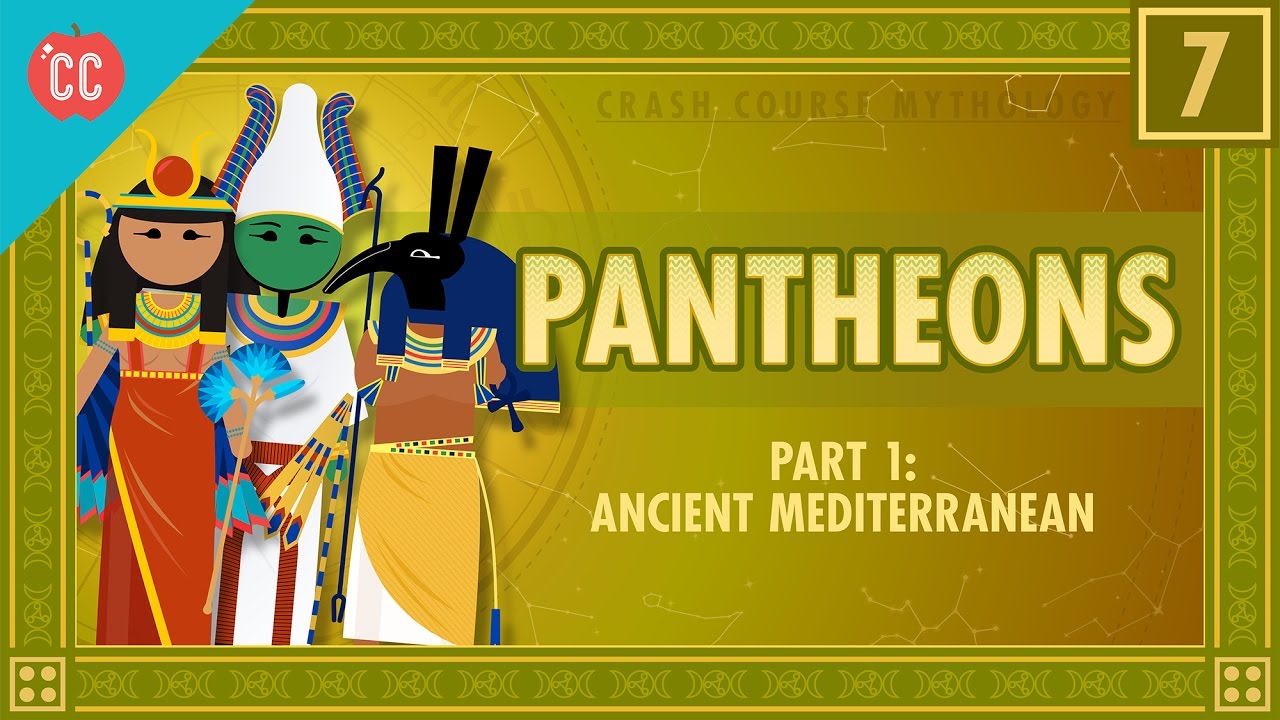
Description
🌳 In which Mike Rugnetta begins our unit on pantheons[ˈpænθiɑn](众神,万神殿), which are families of gods. We further define pantheons and talk about why they're important. Then, we discuss pantheons from the myths of the ancient Mediterranean[ˌmɛdɪtəˈreniən](地中海), starting with ancient Sumer in Mesopotamia[ˌmɛsəpəˈtemiə](美索不达米亚). The Egyptian pantheon brings us the story of Osiris and his envious brother Seth. We learn what these two pantheons suggest about the cultures where they originated.
🌳
1. This is Crash Course Mythology. Today we're going to start looking at pantheons.
Pantheons are families of gods and those families are complicated. Really complicated. A whole tangle of grandparents, and parents, and uncles and aunts, and nieces and nephews, and a couple of children of mortal women who were raped, and a pretty staggering[ˈstæɡərɪŋ][1] amount of violence and incest to just round everything off. They have amazing feasts but honestly could you imagine Thanksgiving dinner with these people. I mean, you had a mistress and a wife and also somehow gave birth to yourself, how is that not awkward.
[1] staggering
adj. 难以置信的,令人震惊的; 蹒跚的; 犹豫的
v. 蹒跚(stagger的现在分词); 使…感到震惊[担心]; 错开
🌳
2. The pantheons we are going to examine are families of deities from cultures that are usually considered polytheistic[ˌpɒlɪθɪ'ɪstɪk](多神崇拜的), meaning that they worshipped more than one god. In most mythological traditions, the gods are seen as immortal, and according to David Leeming, they are, "personified projections of the human mythmaker's dreams of overcoming the inevitable effects of the physical laws that require death and disintegration[dɪsˌɪntɪˈɡreɪʃn](n. 瓦解; 分裂; 崩溃; 〈物〉裂变)." Yeah. We went dark pretty quick.
🌳
3. In creation stories and other myths, gods represent the creative force that brings and sustains life. In many myths, gods are "personifications[pərˌsɑnɪfɪˈkeɪʃn] of aspects of nature and of human nature: the sun, the winds, impatience, love."
Pantheons, David Leeming argues, help us to explain how and why the world we know came into being, and can tell us a lot about a culture. Leeming writes, "All pantheons are ontological and teleological; that is they are metaphors for the human attempt to make sense of existence itself and to assign ultimate cause. To 'read' a pantheon is to read a culture's sense of itself and of the nature of the cosmos." But can pantheons explain the naked mole rat(裸鼹鼠)? Let's find out together.
🌳
4. If you thought I was going to start with the Greeks...ha! gotcha! We're going to start with one of the oldest pantheons we have records for: the family of gods from ancient Sumer in Mesopotamia.
Sumer's pantheon represents the most important natural forces in the lives of Ancient Mesopotamians, and there are a lot of deities here. So strap in(系好安全带). Try to pay attention to everyone's responsibilities, and note what kinds of things don't have gods. Alright, here we go.
🌳
5. The first pair of deities are the earth goddess Ki, and the sky god called An. An mates with Ki, and Nammu, goddess of primal waters. An and Nammu's children are Enki, the trickster god, and his sister, Ningikuga, the goddess of the reeds. An and Ki, the more significant duo, begot Ninlil, the air goddess and Enlil, the air god. Ninlil and Enlil give birth to Nanna, the moon god. Enki and his sister, Ningikuna, create Ningal, the moon goddess. Ningal and Nanna then have three children, Utu the sun god, Inanna, the great goddess of heaven and earth, and Ereshkigal, the queen of the underworld. Ereshkigal's husband is Gugalanna, the Bull of Heaven, and Inanna marries the shepherd Dumuzi. Dumuzi, it turns out, was the son of Enki, the trickster god, and his consort[ˈkɑnˌsɔrt][1], the sheep goddess Sirtur. It may be worth noting that, yes, the sheep goddess did give birth to a shepherd.
[1] consort
n.(统治者的)配偶;一组(古乐器);(演奏几世纪前音乐的)一组乐师
v. 厮混;鬼混
呃(´・ω・`)这段人物关系复杂,大家看图吧
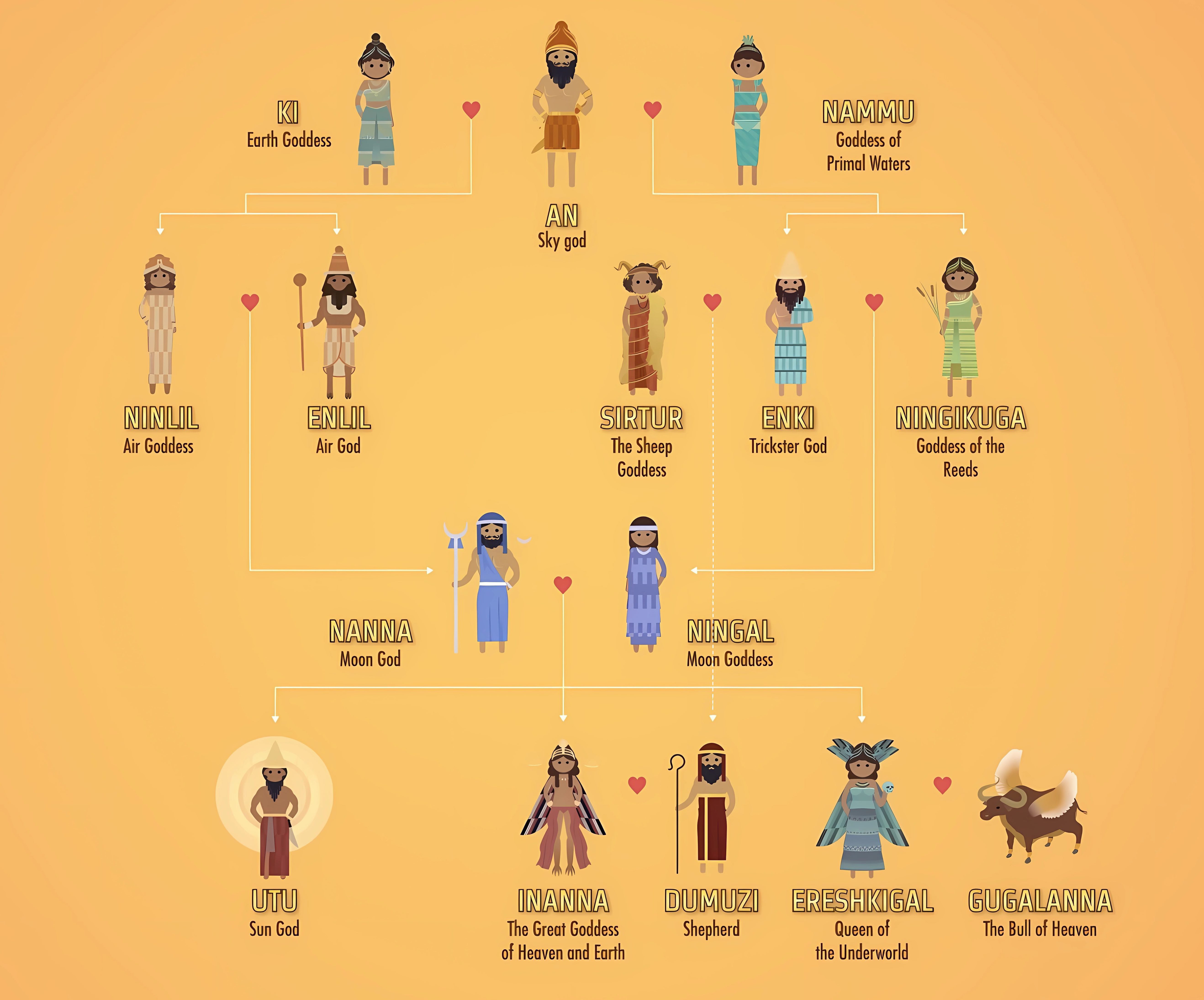 the basic pantheon of Sumer
the basic pantheon of Sumer
🌳
6. So that is the basic pantheon of Sumer, but what does this tell us about Mesopotamia? First it suggests that, at least in terms of their myths, natural phenomena - like the earth and sky - take precedence over human actions and emotions, like love. I mean, only two of the original Mesopotamian gods, Enki the trickster, and Inanna, also the goddess of love, are described as ruling over aspects of human nature.
And the sheep? Well, we tend to think agriculture when we talk about the Fertile Crescent(新月沃地)[1], but the fact that their pantheon features sheep and a bull, rather than a harvest deity, might recall an earlier life as herders. Or perhaps the bull is symbolic, not only of masculinity but also of farming.
[1] Fertile Crescent 新月沃地
新月沃土或称肥沃月弯(Fertile Crescent),是指西亚、北非地区两河流域及附近一连串肥沃的土地,包括黎凡特(Levant,又译作累范特)、美索不达米亚,位于今日的以色列、巴勒斯坦、黎巴嫩、约旦部分地区、叙利亚,以及伊拉克和土耳其的东南部、埃及东北部。由于在地图上好像一弯新月,所以美国芝加哥大学的考古学家詹姆士·布雷斯特德(James Henry Breasted)把这一大片肥美的土地称为“新月沃土”。
🌳
7. This is the fun part of pantheons specifically, and mythology generally: you can read them in many, many ways. That is not a joke about hieroglyphics[ˌhaɪ(ə)rəˈɡlɪfɪks](象形文字), but it does get us to our next significantly more complex family of gods, the Egyptian pantheon(埃及神系). Right off the bat I'm going to say that the Egyptian pantheon is even more confusing than your average confusing pantheon, but surprise surprise, its also just as incestuous.
🌳
8. First off: there is no standard version of the Egyptian pantheon. The myth changes depending upon who is writing it, and where, and when. For example, in the story of Isis(伊西斯) and Osiris(奥西里斯), our most complete source isn't even Egyptian, its the Greek biographer Plutarch(普鲁塔克)[1] who wrote in the first and second centuries CE, well after Egypt had become Hellenized(希腊化), and then Romanized(罗马化). In his version of the Isis and Osiris myths, he gives Egyptian gods Greek names. For example he refers to Thoth as Hermes. He does still give Thoth credit for inventing darts though.
[1] Plutarch 普鲁塔克
罗马帝国时代的希腊作家,哲学家,历史学家,以《比较列传》(οἱ βίοι παράλληλοι又称《希腊罗马名人传》或《希腊罗马英豪列传》)一书闻名后世。
P.S. 希腊和罗马神话同时期存在。
🌳
9. There are also different versions of the pantheon depending upon where you are in Egypt. For the most part we'll be sticking with the group of gods worshiped at the city of Heliopolis(赫利奥波利斯)[1] and headed by Atum(阿图姆)[2] or Ra(拉). But we'll give a nod the fact that in Thebes(底比斯城)[3], the pantheon was led by Amun(阿蒙)[4]. And we can't forget the attempted monotheism[ˈmɑnoʊθiɪzəm](一神教) of Akhenaten(阿肯纳顿)[5]. That was classic. And just to make this even trickier, a lot of the Egyptian sources we have for myths are fragmentary, and they're spread out over thousands of years.
[1] 赫里奥波里斯(Heliopolis),又称“太阳城”,是古埃及最重要的圣地之一。赫里奥波里斯(今埃及开罗)是古代埃及除孟菲斯和底比斯之外最重要的城市,是下埃及十三诺姆的首府。关于赫里奥波里斯城的记载常常出现在金字塔文中。从有关记载可以断定,它是古代埃及太阳神崇拜的中心,也被称为“众神之乡”(相当于希腊神话中的奥林匹斯山)。
[2] 阿图姆(Atum),原本是古埃及神话-赫里奥波里斯体系中的太阳神。在后起的信仰拉出现后,最高神和太阳神的地位逐渐被取代,并与拉融合为一个神的不同神格,被视为黄昏的太阳。常表现为公牛莫努尔(Mnewer)的形象,此外具有蛇、蜥蜴、甲虫、狮子、公牛和姬蜂的外形。
[3] 底比斯城(Thebes),在公元前14世纪中叶的古埃及新王国时期,尼罗河中游,曾经雄踞着一座当时世界上无与伦比的都城。这就是被古希腊大诗人荷马称为“百门之都”的底比斯。历代法老在底比斯建造了大量的神庙、宫殿和陵墓,它们规模宏大,工艺精湛。然千年岁月流逝,宏伟的宫殿庙宇多已堙没无闻,但从仅存的庙宇遗址和帝后陵寝,贵族墓葬,仍可想象当年底比斯鼎盛时期恢弘的风采。
[4] 阿蒙(Amun),古埃及-底比斯主神希腊化的名字,因底比斯的兴起而成为国家的主神,太阳神。
[5] 阿蒙霍特普四世(Amenhotep IV),按不同的时间体系估计,去世于前1351年—前1334年之间,后改名埃赫那顿(Akhenaten,亦译做阿肯纳顿或埃赫那吞),古埃及第十八王朝法老。
🌳
10. So for simplicity, we're going to settle on the Nine-God pantheon(九柱神神系) that forms the core of Egyptian religious belief. And it doesn't include Thoth, sorry pal. The Ennead(九柱神)[1], or Nine Gods was in place in Heliopolis by 2700 BCE, and is the one found in the pyramid texts, which might be the oldest surviving set of religious texts in the world.
[1] The Ennead 九柱神
英语:Ennead,希腊语:Ἐννεάς,就是“九”的意思。在太阳神的崇拜中心赫里奥波里斯(Heliopolis)受到崇拜的九位神祇,也是古埃及神话中最重要的九位主神。
他们分别是:拉Ra(太阳神,埃及神话中的最高神)、舒Shu(风和空气之神)、泰芙努特Tefnut(雨神)、盖布Geb(大地之神)、努特Nut(天空女神)、奥西里斯Osiris(冥王和农业之神)、伊西斯Isis(生命,魔法,婚姻和家庭女神),塞特Set(沙漠和风暴之神),奈芙蒂斯Nephthys(房屋和死者的守护神)。
🌳
11. At the top of this pantheon is Atum, aka Re, aka Ra, aka Khepri, aka Amun, or sometimes Amun-Ra, depending upon where in Egypt you are. This is why we're trying to simplify things. Atum is the great eye of the heavens and of creation. He was the spitter in our Egyptian creation story.
Atum's creative cough creates Shu, the life spirit, and Tefnut, the world order, or cosmos. This brother and sister pair mate and give birth to Geb and Nut. Geb is the spirit of life and Nut is an Egyptian great mother goddess. The two are separated by their father Shu, and Geb becomes earth while Nut becomes the sky and the stars, which is a neat reversal of the whole earth-mother, sky-father thing.
部分九柱神关系图
🌳
12. Like their parents, brother and sister, Geb and Nut, become the mother and father of the rest of the gods, in this pantheon. their children, Osiris and Isis, are probably the best known Egyptian gods, other than hawk-headed(鹰头) Ra. Osiris, god of the underworld and grain, kinda like a Demeter/Hades combo, was probably the most popular of the Egyptian gods. Because hey, who doesn't like food and death. He dies and is revived which happens more than you would expect in myth, actually maybe exactly as much as you would expect in myth. Isis is a goddess of the earth and the moon, and is married to Osiris. The mystery cult of Isis was popular well beyond Egypt into Roman times. And if you're not sure what a mystery cult is, guess what, that's the point.
部分九柱神关系图
🌳
13. The second son, and third child, from the Geb-Nut pairing is Set. Set is a god of evil and darkness, and is the nemesis[ˈnɛmɪsɪs](公正的惩罚; 天罚; 不可逃避的惩罚; 报应) of Isis and Osiris.(Set杀了他哥Osiris) He is married to his sister Nephthys, a goddess of death and dusk, because you know, if you're going to be married for all of eternity it's nice to share interests. (这是什么“地狱”笑话😂)
And the final piece of this puzzle is young Horus(荷鲁斯)[1], not to be confused with old Horus, or the guy from Warhammer(战锤,一款桌面战棋游戏). He was conceived miraculously by Isis and Osiris after the latter's death, and he has aspects of a sun god. He is a light that defeats Set's darkness. Most important though, Horus, who is also depicted with the head of a falcon(隼,猎鹰) - not a hawk(鹰), not an ibis(鹮) - is the spiritual force behind the pharaohs(法老). I know that you're wondering when we're going to talk about Anubis(阿努比斯,导引亡灵的神,豺头人身), Bastet(巴斯泰托,猫神,曾是战神,猫头女神), and Sekhmet(塞赫迈特,凶猛的狮头女神), but remember, for the sake of comparative simplicity, we're sticking with this nine-god pantheon.
[1] Horus 荷鲁斯
古埃及神话中法老的守护神,王权的象征,同时也是复仇之神。他是冥王奥西里斯和伊西斯的儿子,其形象是一位鹰(隼)头人身,头戴埃及王冠,腰围亚麻短裙,手持沃斯(能量)手杖与安卡(生命)符号的神祇。
九柱神关系图
🌳
14. So, what conclusions then can we draw from this basic pantheon. There are multiple versions of sun gods, with Ra representing both he sun and creation, and Horus representing both the sun and kingship(王权). So we can infer that the sun was important to the Egyptians, probably as much for it's eternal cycle of death and rebirth, as for it's providing life-giving energy.
Ancient Egyptian culture is commonly said to focus on death, and that's not wrong. Although death to the Egyptians probably didn't hold the same terror that it does for many in the modern world. I think the most distinct example of this necro-centric(以死亡为核心的) ideal is the pyramids, and the mummified corpses and jars full of organs found within them, but also this weeks featured myth, the story of Isis and Osiris.
🌳
15. Osiris was much beloved by the people of Egypt. He showed them how to cultivate grain, gave them laws, and taught them to honor the gods. His brother Set was envious but wouldn't try anything while Osiris was away teaching civilization to the world. But when Osiris returned, Set and 72 accomplices(共犯;同谋;帮凶) had a plan, a plan involving... furniture[1]. They had secretly measured Osiris's body and had built a beautiful chest(大箱子) to his exact dimensions.
[1] furniture 这里我理解成双关的意思,做手工活和惯常计划。
柯林斯词典查到furniture一个不常见的释义:the attitudes or characteristics that are typical of a person or thing.
eg: the furniture of the murderer's mind
🌳
16. At a party celebrating Osiris's return, Set suggested that whoever fit in the chest would receive it as a gift. Osiris gave it a shot, and when he lay down in the box, the conspirators(阴谋家) nailed it shut and sealed it with lead(铅水). They threw it in the river and it floated out to sea. Isis, Osiris's wife, went looking for her husband and found the chest near the land of Biblos(比卜鲁斯城,今黎巴嫩境内), where a great tree had grown up around it, encasing the coffin in it's trunk. She cut away the wood around the coffin and lay upon it, wailing with such grief and power that the king's younger sons died of fear.
🌳
17. Isis soon left the chest to visit Horus, and Set found the coffin while boar(野猪) hunting. He cut up Osiris's body into 14 pieces and scattered them far and wide. Isis, discovering what Set had done, set out to search for the pieces. She found 13 of them, but not what Izanagi might have described as "his excess". She buried the pieces where she found them, which is why there are so many graves for Osiris in Egypt. Set couldn't find the true grave of Osiris and Osiris would be worshipped throughout Egypt. Win-win, except for the fact that he was dead. Or was he?
🌳
18. This is one version of the story, but in another version, upon finding the body of Osiris, Isis and her sister Nephthys wept such a loud lamentation that Ra the sun god took pity on them and sent down jackal-headed Anubis to help Isis and Nephthys. The two sisters, with the help of Anubis, Thoth, and Horus, pieced Osiris back together and wrapped him in linen bandages and performed the funeral rites. Isis flapped her wings over the body and Osiris revived. From then on he became the king of the dead, ruling in the underworld.
🌳
19. So this myth illustrated some central facets of Egyptian culture. One is the idea of Osiris as a king and a god, much like the pharaohs. Another is the role of mummification in Egyptian life, or death, or well actually both. The binding of Osiris and his revival is a promise to Egyptians of eternal life. According to David Leeming, "Egyptians believed that every man would live eternal in the other world if only his surviving friends did for his body what the gods had done for the body of Osiris; ...as Osiris dies and rose again from the dead, so all men hoped to rise like him..."
🌳
20. This myth also suggests that in Egypt, the pantheon is somewhat fluid, with gods performing numerous roles. Osiris goes from being the father of civilization to the ruler of the underworld, a role that in later Egyptian mythology will be taken over by Anubis. While Set is the source of evil and trouble, the jealous younger brother always trying - and sometimes succeeding - to take the place of his older brother.
🌳
21. There's a tendency to view pantheons as explanations of natural phenomena that corresponds between particular gods and particular aspects of nature, like the sun's rising and setting. But often the gods resist falling into such restrictive roles. And as myths like Isis and Osiris show, it's the particular stories that matter to people, as much, if not more than, who is the goddess of what and why.
Just ask Saga(萨迦,北欧神话中的故事、历史女神), Norse goddess of storytelling. We're going to meet her really soon. But until then, thanks for watching. We'll see you next time. And don't forget to be mythological. Oh, we punted that one, huh?
To be continued…
未完待续…
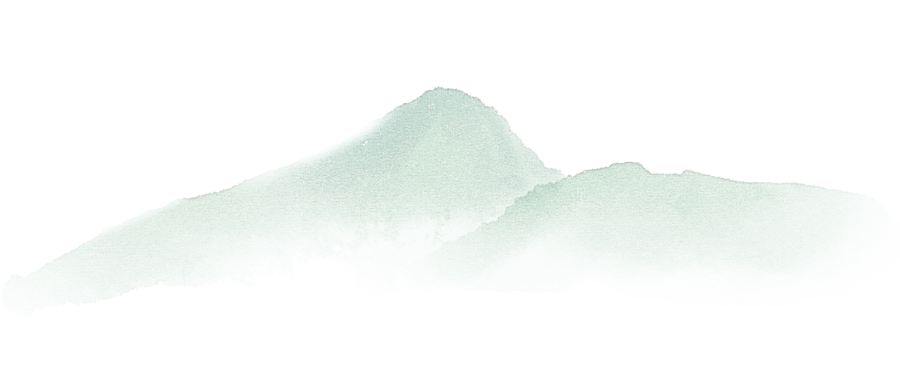
编辑 / 美工 / 校对:🌿香草女巫🧪
